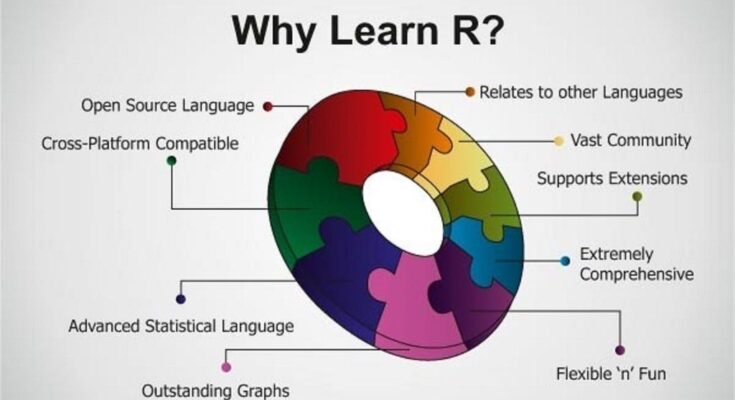R is a powerful programming language and software environment used primarily for statistical computing, data analysis, and visualization. It was developed in the 1990s by Ross Ihaka and Robert Gentleman as a free alternative to the S language, and it has since become one of the most popular tools for data scientists, statisticians, and researchers.
Here are some key aspects of R:
- Data Handling
R supports a wide range of data structures such as vectors, matrices, lists, and data frames, making it ideal for handling complex datasets.
Data frames are particularly useful in R as they allow you to handle tabular data easily, similar to spreadsheets or SQL tables. - Packages
R has a comprehensive ecosystem of packages. The Comprehensive R Archive Network (CRAN) hosts thousands of packages that extend R’s functionality in areas such as machine learning, econometrics, bioinformatics, and more.
Popular packages include:
ggplot2 for data visualization.
dplyr and tidyr for data manipulation.
shiny for building interactive web apps. - Statistical Analysis
R is widely used for performing statistical tests, such as hypothesis testing, regression analysis, time series analysis, and ANOVA.
It includes numerous built-in functions for descriptive statistics, probability distributions, and inferential statistics. - Data Visualization
R excels in creating high-quality data visualizations. The ggplot2 package is renowned for making complex and aesthetically pleasing plots, such as histograms, scatter plots, line plots, and more.
R also provides base plotting functions, although packages like ggplot2 offer more flexibility and customization. - Machine Learning
R has robust machine learning capabilities through packages like caret, randomForest, xgboost, and e1071. These libraries support tasks such as classification, regression, clustering, and dimensionality reduction. - Integration
R can be integrated with other languages (such as Python, C++, and Java) and with various databases (such as MySQL, PostgreSQL).
RStudio is a popular IDE that provides an integrated environment for writing and running R code.
Example Code Snippet
r
Copy code
Basic data frame creation
df <- data.frame(
Name = c(“Alice”, “Bob”, “Charlie”),
Age = c(25, 30, 35),
Height = c(5.5, 6.0, 5.8)
)
Print the data frame
print(df)
Summarize the data frame
summary(df)
Plotting using ggplot2
library(ggplot2)
ggplot(df, aes(x = Name, y = Height)) +
geom_bar(stat = “identity”) +
theme_minimal()
Would you like to dive into a specific area of R, like data manipulation, visualization, or statistical modeling?
Plotting
ggplot2 is one of the most popular libraries in R for data visualization. It allows users to create complex, multi-layered visualizations in a simple and intuitive way by following the “grammar of graphics” philosophy. The idea is to build plots layer by layer, which offers flexibility in design and customization.
Key Components of ggplot2
Data: The data set you’re visualizing.
Aesthetic Mappings (aes): This defines how variables in the data are mapped to visual properties (like x/y axis, colors, size).
Geometries (geom): The type of plot (e.g., scatter plot, bar chart, line plot).
Facets: Allows for splitting data into multiple subplots.
Scales: Control how data is mapped to visual properties like axis limits, colors, etc.
Themes: Adjust the non-data elements of the plot (like background, grids, font sizes).
Basic Structure
r
Copy code
ggplot(data = , aes()) +
() +
Example: Scatter Plot
Let’s create a simple scatter plot using ggplot2 with the mtcars dataset, a built-in dataset in R.
r
Copy code
Load ggplot2 library
library(ggplot2)
Load the mtcars dataset
data(mtcars)
Create a scatter plot of mpg vs hp (miles per gallon vs horsepower)
ggplot(mtcars, aes(x = hp, y = mpg)) +
geom_point() +
labs(title = “Scatter plot of MPG vs Horsepower”,
x = “Horsepower (hp)”,
y = “Miles per Gallon (mpg)”) +
theme_minimal()
Explanation:
ggplot(mtcars, aes(x = hp, y = mpg)): Initializes the plot by specifying the data (mtcars) and the aesthetic mappings (aes), where x = hp and y = mpg.
geom_point(): Adds points (scatter plot).
labs(): Adds labels and a title to the plot.
theme_minimal(): Applies a clean and minimalistic theme to the plot.
Example: Bar Plot
Now, let’s create a bar plot to visualize the number of cars with different numbers of cylinders.
r
Copy code
Bar plot of number of cylinders
ggplot(mtcars, aes(x = factor(cyl))) +
geom_bar(fill = “steelblue”) +
labs(title = “Bar Plot of Cylinder Counts”,
x = “Number of Cylinders”,
y = “Count of Cars”) +
theme_classic()
Explanation:
factor(cyl): Converts cyl to a factor (categorical variable).
geom_bar(): Creates a bar plot. The fill argument is used to set the color of the bars.
theme_classic(): Applies a classic, clean theme to the plot.
Example: Line Plot
Let’s now create a line plot using a time series dataset.
r
Copy code
Create a simple time series data frame
df <- data.frame(
year = c(2010, 2011, 2012, 2013, 2014),
value = c(100, 120, 140, 160, 180)
)
Line plot of year vs value
ggplot(df, aes(x = year, y = value)) +
geom_line(color = “darkred”, size = 1) +
geom_point(size = 3) +
labs(title = “Line Plot Example”,
x = “Year”,
y = “Value”) +
theme_minimal()
Example: Customizing Colors and Themes
You can customize colors, themes, and other plot elements to enhance readability.
r
Copy code
Customizing color by a third variable (gear)
ggplot(mtcars, aes(x = hp, y = mpg, color = factor(gear))) +
geom_point(size = 3) +
labs(title = “Scatter plot of MPG vs Horsepower by Gear”,
x = “Horsepower (hp)”,
y = “Miles per Gallon (mpg)”,
color = “Gear”) +
theme_bw()
Explanation:
aes(color = factor(gear)): Maps the gear variable to the color of the points.
geom_point(size = 3): Increases the size of the points for better visibility.
theme_bw(): Applies a black-and-white theme to the plot.
Saving the Plot
You can save your plot to an image file using ggsave().
r
Copy code
Save the plot to a file
ggsave(“myplot.png”, width = 8, height = 6)
More Geometries
geom_histogram(): For histograms.
geom_boxplot(): For box plots.
geom_smooth(): For adding trend lines (e.g., linear regression lines).
geom_density(): For density plots.
Would you like to explore any specific type of plot further, or need help with a custom visualization?
In R, data visualization is a core strength, providing many tools to create rich, flexible, and visually appealing graphics. The two primary systems for visualization in R are base R plotting and ggplot2, a part of the tidyverse package ecosystem. Additionally, there are specialized libraries for interactive graphics, such as plotly, highcharter, and shiny.
Here’s an overview of visualization in R, ranging from basic to advanced techniques:
- Base R Graphics
R’s base graphics system is simple and works out-of-the-box. However, it has limitations in terms of flexibility compared to ggplot2. Here’s a simple example of base R plotting:
Example: Scatter Plot in Base R
r
Copy code
Basic scatter plot using base R
plot(mtcars$hp, mtcars$mpg,
main = “Scatter plot of HP vs MPG”,
xlab = “Horsepower”,
ylab = “Miles per Gallon”,
col = “blue”, pch = 19)
Example: Histogram in Base R
r
Copy code
Histogram in base R
hist(mtcars$mpg,
main = “Histogram of MPG”,
xlab = “Miles per Gallon”,
col = “lightblue”, border = “black”)
- ggplot2: Grammar of Graphics
As mentioned earlier, ggplot2 provides a more structured and flexible way to build complex visualizations layer by layer. This is generally preferred over base R plotting for most tasks due to its flexibility.
Example: Basic Scatter Plot using ggplot2
r
Copy code
library(ggplot2)
Scatter plot with ggplot2
ggplot(mtcars, aes(x = hp, y = mpg)) +
geom_point() +
labs(title = “Scatter plot of HP vs MPG”,
x = “Horsepower (HP)”,
y = “Miles per Gallon (MPG)”) +
theme_minimal()
Example: Histogram using ggplot2
r
Copy code
Histogram in ggplot2
ggplot(mtcars, aes(x = mpg)) +
geom_histogram(binwidth = 2, fill = “skyblue”, color = “black”) +
labs(title = “Histogram of MPG”,
x = “Miles per Gallon”,
y = “Count”) +
theme_light()
- Faceting and Multiple Plots
ggplot2 makes it easy to create multiple plots based on a factor variable.
Example: Faceting in ggplot2
r
Copy code
Faceting by number of gears
ggplot(mtcars, aes(x = hp, y = mpg)) +
geom_point() +
facet_wrap(~ gear) +
labs(title = “MPG vs HP by Number of Gears”,
x = “Horsepower”,
y = “Miles per Gallon”) +
theme_bw()
- Interactive Graphics
For interactive graphics, you can use plotly, highcharter, or shiny. These allow for interactive zooming, panning, and other dynamic features.
Example: Interactive Plot with plotly
r
Copy code
library(plotly)
Create an interactive scatter plot
p <- ggplot(mtcars, aes(x = hp, y = mpg, color = factor(gear))) +
geom_point(size = 3) +
labs(title = “Interactive Scatter plot of HP vs MPG by Gear”)
Convert the ggplot object into an interactive plot
ggplotly(p)
Example: Using shiny for Interactive Dashboards
shiny is used to create web-based interactive applications. It’s perfect for building dashboards that react to user inputs like sliders, text boxes, etc.
Here’s a minimal example:
r
Copy code
library(shiny)
library(ggplot2)
Define UI for the application
ui <- fluidPage(
titlePanel(“MPG vs Horsepower Scatter Plot”),
sidebarLayout(
sidebarPanel(
sliderInput(“hpRange”, “Horsepower Range:”, min(mtcars$hp), max(mtcars$hp),
value = c(100, 300))
),
mainPanel(
plotOutput(“scatterPlot”)
)
)
)
Define server logic
server <- function(input, output) { output$scatterPlot <- renderPlot({ ggplot(mtcars[mtcars$hp >= input$hpRange[1] & mtcars$hp <= input$hpRange[2], ],
aes(x = hp, y = mpg)) +
geom_point() +
labs(title = “MPG vs Horsepower”,
x = “Horsepower”,
y = “Miles per Gallon”)
})
}
Run the application
shinyApp(ui = ui, server = server)
- Advanced Plot Customization in ggplot2
You can customize almost every element of a plot in ggplot2. You can tweak axis scales, labels, titles, colors, legends, and much more.
Example: Customized Plot with ggplot2
r
Copy code
Customized scatter plot with ggplot2
ggplot(mtcars, aes(x = hp, y = mpg, color = factor(cyl), size = wt)) +
geom_point(alpha = 0.7) +
scale_color_manual(values = c(“red”, “green”, “blue”)) +
labs(title = “Customized Scatter Plot of MPG vs HP”,
subtitle = “Colored by Number of Cylinders”,
x = “Horsepower”,
y = “Miles per Gallon”,
color = “Cylinders”) +
theme_minimal(base_size = 15)
- Specialized Visualizations
R supports many specialized visualizations such as heatmaps, correlograms, dendrograms, and more.
Example: Heatmap
r
Copy code
Generate random data for a heatmap
data_matrix <- matrix(rnorm(100), nrow = 10)
heatmap(data_matrix, main = “Random Heatmap”, col = heat.colors(256))
Example: Correlation Plot (Correlogram)
r
Copy code
library(corrplot)
Correlation plot for mtcars dataset
cor_matrix <- cor(mtcars)
corrplot(cor_matrix, method = “circle”)
- Saving and Exporting Plots
Once you’ve created a plot, it’s easy to save it in different formats like PNG, PDF, or JPEG.
Example: Save a Plot
r
Copy code
Save the plot to a file
ggsave(“scatter_plot.png”, width = 8, height = 6)
Summary of Visualization Libraries:
Base R: Good for quick, simple plots but lacks flexibility for customization.
ggplot2: Highly flexible, intuitive, and powerful; ideal for most plotting needs.
plotly: Adds interactivity to static ggplots.
shiny: Enables building interactive web applications and dashboards.
corrplot: Specializes in correlation plots.
lattice: Another graphics package, similar to ggplot2, but less commonly used now.
Would you like to explore any specific types of visualizations in more detail?



